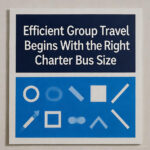When groups begin the process of organizing transportation for an event, be it a corporate shuttle or a specialized journey requiring a 32 passenger bus rental, the resulting quote for a coach bus can often feel arbitrary. It’s easy to assume the price is simply based on the distance traveled, a straightforward rate per mile. However, the true anatomy of today’s bus rental pricing is a complex reflection of fixed infrastructure, volatile operational expenses, and logistical necessity. Understanding the final figure requires moving past the surface-level assumption and diving into the economic realities of running a fleet.
Every quoted dollar must account for everything from federal safety compliance and driver regulations to local parking fees and global fuel market shifts. The price is not merely a charge for the ride; it is the cost of coordinating a sophisticated, safe, and regulated service designed to move dozens of people efficiently. To make informed booking decisions, one must first appreciate the many interconnected factors that contribute to the bottom line.
The Foundational Cost: Vehicle Capacity and Class
The most immediate influence on a rental price is the vehicle itself – specifically, its size and the level of luxury it commands. Larger motorcoaches, which offer features like restrooms, Wi-Fi, and extensive undercarriage storage, naturally have higher fixed operating costs, insurance premiums, and maintenance needs than smaller alternatives. This is why groups must carefully match their headcount to the available fleet. For many mid-sized groups seeking a balance of comfort and value, the specifications of a 32-passenger bus rental often represent the sweet spot, providing ample seating without the fuel and maintenance overhead of a 56-passenger giant.
Here’s how vehicle characteristics impact pricing:
- Size/Capacity: Larger buses (e.g., 56-passenger motorcoaches) generally cost more due to higher operational expenses.
- Amenities: Features like restrooms, Wi-Fi, entertainment systems, and air conditioning add to the rental cost.
- Luxury Level: Premium seating, advanced interiors, and specialized vehicles (e.g., entertainer coaches) command higher prices.
- Maintenance & Insurance: These overheads are factored into the rental rate and are higher for larger, more complex vehicles.
Companies diversify their fleets – from compact minibuses to deluxe entertainer coaches – precisely because each vehicle type caters to a different price point and trip requirement. Ultimately, the more specialized the vehicle, the more amenities it carries, and the more premium its seating, the higher the initial rate will be, regardless of how short the journey.
The Hidden Costs of Logistics: Deadhead and Location
The concept of “deadhead” is arguably the least understood and most significant hidden variable in bus rental quotes. Deadhead refers to the mileage a bus travels without passengers – driving from its depot to the pickup location and returning to the depot after the final drop-off. This distance still requires fuel, driver time, and vehicle wear, and those costs must be passed on to the renter. The starting location is therefore critical; utilizing a Chicago bus rental service for a trip starting in Chicago, where the supply of vehicles is high, minimizes the non-revenue-generating deadhead mileage. Conversely, arranging a pickup far from a company’s operating hub can significantly inflate the price. Furthermore, the quote incorporates route-specific fees, such as metropolitan parking permits (which can be substantial in dense urban centers), state-specific taxes, and bridge or highway tolls, turning logistical coordination into a notable cost component.
The Economic Pressures: Fuel, Maintenance, and Insurance
The fundamental operating costs of a bus company form a massive, fluctuating base layer beneath every rental quote. The price volatility of diesel fuel, for instance, has an immediate and direct impact, often necessitating the incorporation of fuel surcharges to protect operational solvency. Beyond the pump, the costs associated with maintaining a federally regulated motorcoach fleet are among the highest in the vehicle industry, requiring specialized mechanics, expensive parts, and significant downtime to meet safety standards.
Furthermore, insurance premiums for commercial passenger transport are similarly high, reflecting the substantial risk involved. When groups investigate coach bus rental prices, they are essentially absorbing fractions of these vast, non-negotiable fixed costs.
A reliable company doesn’t merely estimate the miles; it strategically prices its services to ensure long-term viability against these systemic economic pressures, ensuring that safety and mechanical integrity are never compromised for the sake of a lower number.
The Temporal Variable: Duration and Seasonality
A major complexity in pricing lies in how duration is measured, which shifts based on the trip’s profile. For local, short-duration shuttles, pricing is nearly always hourly, typically with a mandatory four-to-five-hour minimum to cover the initial operational costs and driver shifts. Extended or multi-day journeys, however, switch to daily or mileage-based pricing. The daily rate usually includes an allowance of miles, with a surcharge kicking in only if that limit is exceeded. Here’s how duration and seasonality influence pricing:
- Hourly Rates: Applied to local, short-duration trips, often with a 4-5 hour minimum.
- Daily/Mileage Rates: Used for extended or multi-day journeys, typically including a set mileage allowance before surcharges apply.
- Peak Season Surcharges: Prices increase during high-demand periods (spring, early summer, major holidays) due to limited vehicle availability.
- Off-Peak Discounts: Conversely, lower demand seasons (e.g., late January) often see more competitive pricing.
This pricing mechanism is complicated further by seasonality. Peak demand periods, notably the spring and early summer (driven by school trips, graduations, and major festivals), and major holidays, tighten vehicle supply significantly. During these high-volume windows, companies adjust their rates upward to manage demand and allocate resources, meaning a trip in May can cost substantially more than the identical trip scheduled for late January. Timing, therefore, is an invisible component factored into every final cost calculation.
Value Over Price: A Coordinated Investment
Ultimately, the quote for a coach bus rental is not a simple commodity price; it is a calculation of coordinated logistics, guaranteed safety, and operational excellence. The final figure weaves together the fixed cost of the vehicle’s capacity, the variable charges of macroeconomic factors like fuel and insurance, the specific logistical requirements of deadhead mileage and tolls, and the market pressures of peak seasonal demand. When evaluating coach bus rental prices, groups seeking the lowest possible number often fail to realize they may be sacrificing reliability or regulatory adherence for a cheaper rate. A higher, transparent quote reflects a company’s necessary investment in driver training, fleet maintenance, and comprehensive insurance – elements essential for a safe, seamless journey. By understanding the complexity behind the pricing, travelers can move past mere cost comparison and focus on securing genuine value: a secure, professionally managed service that makes the entire transportation experience predictable.






